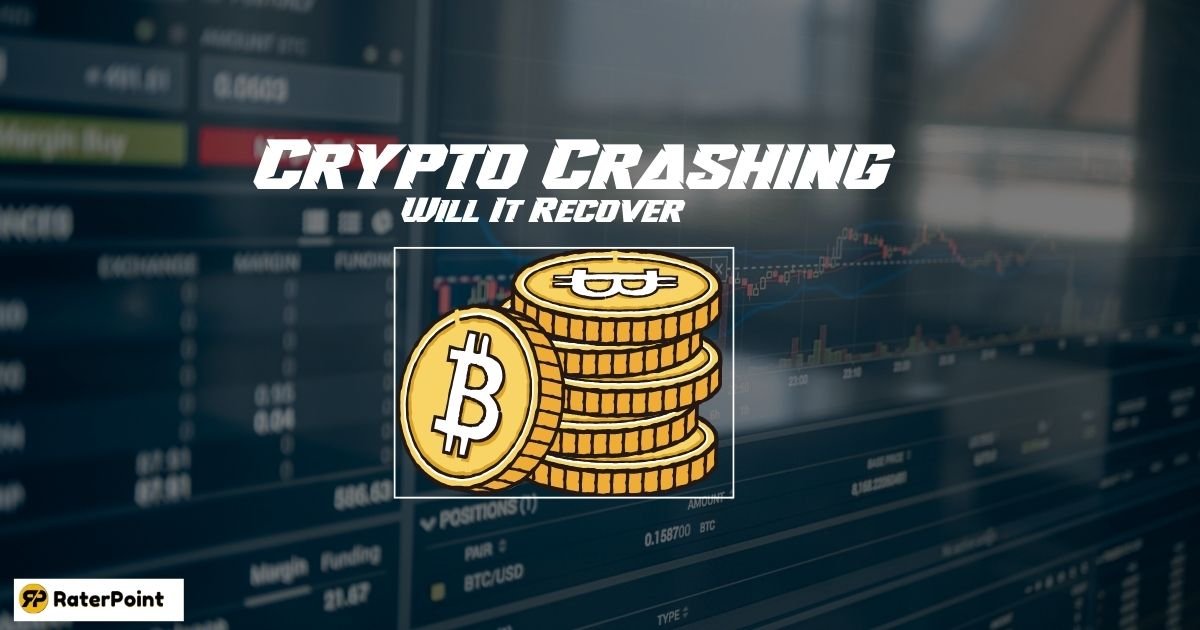Why is Crypto Crashing and Will It Recover?

The crypto market is known for being exciting but it is also unpredictable. One day prices are rising fast, and the next, coins like Bitcoin or Ethereum can lose thousands of dollars in value within hours.
The crypto market is once again in the spotlight after Bitcoin fell to around $112,174, with many pointing to a $2 billion whale sell-off as the cause.
But sudden drops like this aren’t new. A crypto crash simply means a sharp fall in prices across the market, often triggered by panic selling, big investor moves, or global news.
Looking back, Bitcoin has faced many big crashes from losing 99% in 2011 after a major exchange hack, to dropping more than 50% during the 2020 pandemic. Each time, it shook investor confidence, yet the market eventually recovered. That history shows us one thing: crashes are part of crypto’s journey, not the end of it.
In this blog post we will learn in detail about why crypto is crashing and will it recover?
Why is Crypto Crashing Right Now?
Crypto prices don’t fall for just one reason it’s usually a mix of global events, investor behavior, and market problems.
Let’s break down the main causes behind the latest crash.
Global Economic Conditions
The world economy has a big impact on crypto. When interest rates go up and inflation rises, people prefer safer investments instead of risky assets like Bitcoin. Crypto also often moves with the stock market. If stocks drop, crypto usually follows.
On top of that, a strong U.S. dollar makes digital coins less attractive, pushing prices down.
Regulatory Pressures
Governments around the world are keeping a close eye on crypto.
The SEC in the U.S. has filed lawsuits against exchanges, and some countries have even banned certain coins or trading activities. These crackdowns create uncertainty, and when investors don’t feel safe, they sell.
Market Sentiment and Panic Selling
Sometimes, fear spreads faster than facts. When people see prices drop, they panic and start selling to avoid bigger losses. Social media and news headlines can make the fear worse, turning small dips into full crashes.
Large holders, known as whales, can make things even worse by selling billions worth of coins in a short time just like the recent $2 billion Bitcoin sell-off.
Failures of Major Projects/Exchanges
Crypto’s history is full of high-profile failures. The FTX collapse, the Luna crash, and multiple exchange hacks all caused huge sell-offs.
When big projects fail, it shakes trust in the whole market, even for investors who weren’t directly involved.
Profit loss is part of crypto, although if you want to to grow your learn the calculation method: How to Calculate 10x in Crypto?
Speculation and Overvaluation
Not all crashes come from bad news sometimes, it’s because prices rise too fast. Overhyped projects, like meme coins, create bubbles that eventually burst.
This cycle of big gains followed by sharp losses has happened many times in crypto history.
Will Crypto Recover?

Crypto crashes often feel like the end, but history shows that the market has bounced back many times.
To understand the chances of recovery, let’s look at past trends, adoption, and signals that point to where things may go next.
Historical Recovery Patterns
If you look at Bitcoin and Ethereum, both have survived multiple crashes. For example, after Bitcoin lost over 80% in 2018, it slowly rebuilt momentum and later hit new record highs. The same happened after the 2020 pandemic crash — prices fell below $4,000 but climbed past $60,000 within a year.
This pattern shows a cycle: boom → crash → consolidation → growth. In simple terms, after every major fall, the market tends to stabilize, regain confidence, and move upward again. While the timing is never exact, recovery has been a repeating theme in crypto’s history.
Long-Term Adoption Factors
The long-term health of crypto depends on adoption. Big institutions like banks, hedge funds, and ETFs are now getting involved in digital assets. This brings more trust and stability to the market.
At the same time, blockchain technology is finding real-world uses beyond just trading coins. Projects in DeFi, NFTs, and Web3 are shaping new financial systems, gaming, and digital ownership.
Even regulations once seen as a threat could make crypto safer by protecting investors and removing bad actors. These adoption trends make a strong case for recovery in the future.
Key Indicators of Potential Recovery
There are also signs to watch if you’re looking for recovery signals:
- Bitcoin halving cycles: Every four years, the reward for mining Bitcoin is cut in half. History shows these events often lead to price increases months later.
- Market cap stabilization: If the overall value of the crypto market stops falling and holds steady, it can be the first step toward recovery.
New investors and institutions: When fresh money enters the market from retail traders or large funds it often drives prices upward again.
These indicators don’t guarantee a comeback, but they give clues about where the market might be heading.
2x, 4x, 10x leverage is very common in crypto trade. If you don’t know how common is 2x in crypto Click Here.
When Will Crypto Recover?
No one can give an exact date for when crypto will recover, but history gives us some clues. In past crashes, Bitcoin and other coins often took months or even years to bounce back. For example, after the 2018 crash, it took almost two years before Bitcoin reached new highs.
Recovery depends on several factors:
- Global economy: If inflation cools and interest rates drop, risky assets like crypto often perform better.
- Investor confidence: Once fear fades and new money flows in, prices usually stabilize.
- Innovation and adoption: Growth in areas like DeFi, NFTs, Web3, and institutional investment can speed up recovery.
- Bitcoin halving cycles: Historically, prices tend to rise in the months following these events.
The key takeaway is this: recovery is possible, but it rarely happens overnight. Patience and long-term thinking matter more than trying to time the exact bottom.
What is the Future of Crypto?
Even with all the crashes, crypto has proven that it’s not going away. Each downturn has led to new lessons, stronger projects, and more serious adoption.
Big players like banks, investment funds, and tech companies are now entering the space, which makes the market more stable than in the early days.
The future of crypto will likely be shaped by:
- Better regulation that protects investors and reduces scams.
- More real-world use cases, from payments to gaming to digital identity.
- Continued innovation in DeFi, NFTs, and Web3 technology.
- Institutional adoption, with companies and funds treating crypto as a normal part of finance.
While prices will always have ups and downs, crypto is slowly moving toward becoming part of everyday life. For investors, this means that the future could be bright — but it requires patience, smart choices, and a focus on the long term.
How Investors Can Respond During a Crypto Crash – Raterpoint Suggestions

When prices drop fast, it’s easy to panic. But smart investors use simple strategies to protect themselves and prepare for recovery. Here are a few key tips:
Avoiding Panic Selling
- Selling too quickly often locks in losses.
- Markets move in cycles — what looks like the end today can turn into an opportunity tomorrow.
Diversification and Risk Management
- Don’t put all your money into one coin.
- Spread investments across different assets (stocks, crypto, or even gold) to lower risks.
Dollar-Cost Averaging (DCA)
- Instead of investing all at once, buy small amounts regularly.
- This way, you smooth out price changes and avoid buying only at highs.
Only Invest What You Can Afford to Lose
- Crypto is risky to never invest rent, savings, or emergency money.
- Think of it as a high-risk, long-term bet, not a guaranteed win.
Expert Prediction and Opinion
This video has complete expert analysis:
FAQs
Why is crypto crashing today?
Crypto is falling because of a mix of reasons — large investors (whales) selling billions in Bitcoin, global economic pressures like high interest rates, and fear spreading among smaller traders. News about regulations or lawsuits can also trigger sudden drops.
Will Bitcoin recover again?
History suggests yes. Bitcoin has crashed many times, sometimes losing over 80% of its value, but it has always managed to bounce back and even set new records. Recovery takes time, but past cycles show it’s possible.
How long does a crypto crash usually last?
There’s no fixed timeline. Some crashes lasted a few months, while others took over a year before recovery. It depends on the economy, investor confidence, and new money entering the market.
Is crypto a safe long-term investment?
Crypto can be rewarding but it’s not fully safe. It’s still more risky than stocks or real estate. That’s why most experts say to treat crypto as part of a bigger portfolio and never invest money you can’t afford to lose.
Should I buy crypto during a crash?
Some investors see crashes as buying opportunities, while others prefer to wait until the market stabilizes. A safer approach is dollar-cost averaging buying small amounts over time instead of all at once.
Conclusion
The recent crash, where Bitcoin dropped to nearly $112,000, shows how quickly the crypto market can change. Factors like whale sell-offs, global economic pressure, regulations, panic selling, and project failures all play a role in these sharp downturns.
But history reminds us that crashes are nothing new in crypto. From the early days of exchange hacks to the 2017 bubble burst and the 2020 pandemic crash, the market has fallen hard before and yet, it always found a way to recover.
The future of crypto looks promising with growing adoption, new technology, and more institutional interest, but investors should stay realistic. Recovery takes time, and the road is never smooth.
The best approach is simple: stay informed, invest wisely, and don’t follow the hype blindly.

